Temporary gentlemen
Temporary gentlemen (sometimes abbreviated to TG) is a colloquial term referring to officers of the British Army who held temporary (or war-duration) commissions, particularly when such men came from outside the traditional "officer class".

Historically the officers of the British Army were drawn from the gentry and upper middle-classes and the expensive uniforms and social expectations placed on officers prevented those without a private income from joining. The outbreak of the First World War required a rapid expansion in the size of the army and a corresponding increase in the officer corps. During the war more than 265,000 additional officers were recruited, many on temporary commissions. Many of these were drawn from the lower middle and working classes. They came to be referred to as "temporary gentlemen" with the expectation being that they would revert to their former social standing after the war. At the end of the war, many were unwilling to return to their former positions on reduced salaries and there were too few managerial positions to provide full employment, resulting in considerable hardship. Many former temporary gentlemen became leading literary figures and temporary gentlemen featured in many inter-war stories, plays and films.
The term was revived in the Second World War, which saw a similar increase in the number of officers holding temporary commissions. A staggered demobilisation at the war's end helped alleviate some of the issues faced by their forebears. The term continued to see use for officers commissioned from those conscripted for National Service, which lasted until 1963. It has also been used as a translation for miliciano, a term used to describe conscript officers in the Portuguese Army of the 1960s and 1970s.
Background

Until the Cardwell Reforms of 1871 officers' commissions in the British Army were achieved by purchase, except for those in the artillery or engineers. A substantial sum of money was required to enter the profession and to progress via promotion, when the new commission had to be purchased.[1] The official price ranged in the line infantry from £450 for an ensign to £4,500 for a lieutenant colonel. Cavalry commissions were more costly, and those in the foot guards the most expensive at £1,200 for an ensign and £9,000 for a lieutenant-colonel.[2] The purchase was handled by an auction house in London and buyers were often required to pay a supplementary over-regulation or "regimental" price, which varied depending on how popular the regiment was. Sometimes this was many times greater than the official rate; James Brudenell, 7th Earl of Cardigan was reported to have paid £40,000 in 1836 for the lieutenant colonelcy of the 11th Hussars.[3][4] The profession was therefore only open to the wealthy; it was popularly chosen for the younger sons of the gentry and aristocracy, who would not inherit the family estates and who could sell their commissions upon retirement (provided they did not die, were not promoted to general rank or cashiered for poor behaviour).[1][5] The purchase system also meant that the government did not need to provide a proper salary or pension to officers, saving costs.[1]
Landed families developed traditions of service, with successive generations serving in the same regiment.[6] Such men were considered gentlemen, a term encompassing the upper portion of the British class system, inheriting this status from their fathers and holding it for life no matter their behaviour.[7] Due to this close connection, holders of officers' commissions generally came to be regarded as gentlemen by association, as reflected in the phrase an officer and a gentleman.[8][7] Many of the traditional "officer class" had attended public schools, and sometimes universities, with Officers' Training Corps (OTC) units and so had been in training for the role from the age of thirteen.[6]
Even after the purchase system was abolished the profession of army officer remained largely the preserve of the landed classes. Officers were required to take part in expensive sports, such as polo, and pay high mess bills. This required a significant private income which precluded the lower classes.[9] Officers also had to purchase their own uniforms and equipment, which cost at least £200 in the infantry and £600–£1,000 in the cavalry, and, depending on regimental practice, pay subscriptions to provide coaches, bands, theatre tickets, wine cellars and packs of hunting hounds.[2] In 1900 it was estimated that a junior officer in the 10th Royal Hussars, renowned as the most expensive in the army, required a private income of £500 per year as a bare minimum. The Coldstream Guards considered £400 per year as a requirement of entry for new officers and the rest of the Household Brigade £300.[10] In unfashionable regiments (those less popular to new officers) such as the artillery and engineers and some infantry regiments it was considered possible to live on a private income of £60–100.[2] Officers' pay had not increased since 1806 with the most junior officers receiving a salary of £95 16s 3d (£95.81) per year, much below what professionals earnt in the private sector.[11]
Efforts were made to reform the profession in the early-Edwardian era but were stymied by resistance from serving officers and a reluctance by the government to provide funding for subsidies to those without the means to maintain the lifestyle.[12] Only a small number of non-gentlemen were granted commissions, often those acting in professional roles such as veterinarians or paymasters.[1] In contrast, the enlisted ranks were almost all drawn from the working class and in the ten years from 1903 an average of just 11 officers per year were commissioned from the ranks.[13][14]
First World War
.jpg.webp)
The term "temporary gentlemen" first came to prominence during the First World War to describe officers who received temporary (or war duration) commissions, often men from outside the traditional officer class. It was sometimes abbreviated to "TG".[15] The term was used by traditional officers to remind temporary officers that they were expected to resume their former positions after the war and was considered offensive by most of those to which it was applied.[16][17] The use of the term reduced once the new officers had proved themselves capable on the battlefield, though some temporary officers adopted the term in an ironic fashion.[17] Some temporary gentlemen used the term themselves to refer to those promoted from the ranks, though these men were also referred to as "ranker officers".[17][18] The war poet Wilfred Owen used this form of the term when he wrote a letter to his mother describing "temporary gentlemen ... glorified NCOs [non-commissioned officers] ... privates and sergeants in masquerade" and how he would "rather be among honest privates than these snobs".[17]
Sometimes the opposite situation occurred when men who would seemingly have no problems fulfilling the requirements to hold a commission in peacetime chose instead to serve in the ranks during the war. This included the Earl of Crawford who, at the age of 45, served as a lance corporal and Leslie Coulson, assistant editor of The Morning Post who refused a commission in order to "do the thing fairly [and] take [his] place in the ranks" (he died as a sergeant in the London Regiment at the Battle of Le Transloy in 1916).[19]
Outbreak of war
At the outbreak of the war there were 10,800 officers in the British Army with an additional 2,500 in the Special Reserve and 10,700 in the Territorial Force, which was 2,000 below the British Army's theoretical full strength. During the next four years some 265,397 men became officers, mostly on temporary commissions—with the intention being that they would return to civilian life after the war was over.[20][21]
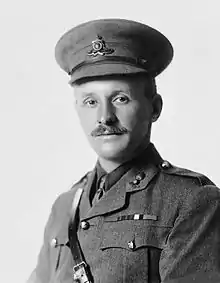
Some men were commissioned directly from the ranks in the early stages of the war, mainly senior NCOs and warrant officers from the regular army.[19] On 1 October 1914 an unprecedented 187 men were commissioned in this manner, the largest single influx of working-class officers the army had ever received.[13] By the end of 1914 almost 1,000 enlisted men had received officers' commissions and by the end of the war in 1918 some 10,000 had been commissioned.[23][24]
Enlisted men who took up this offer at this stage of the war were discharged from the regular army and appointed to temporary commissions, a process that caused problems upon demobilisation when many wished to continue their service in the army. Those who received commissions in this manner included the Royal Artillery's Sergeant Major George Thomas Dorrell and Sergeant David Nelson, who both won Victoria Crosses for gallantry during the Action at Néry on 1 September 1914.[19]
Some NCOs who received temporary commissions found themselves in financial difficulty as they lost their entitlement to additional pay while on active service. Many NCOs therefore refused to accept advancement, while others had to be "forced to take commissions to their financial detriment".[25] The issue was partly remedied later in the war with the introduction of grants to all officers below the rank of major and allowances paid for officer's children.[25] By 1916 all subalterns received 7s 6d (£0.38) a day in pay, an initial £50 kit allowance, a 2s (£0.10) daily lodging allowance, 2s 6d (£0.13) daily field service allowance and free mess rations and travel.[26] A newly commissioned officer on active service could therefore earn upwards of £210 per year, on top of which some civilian employers also continued to pay their former employees half wages.[27][26] As such, during the later part of the war temporary gentlemen on active service had few financial concerns.[26]
Former NCOs sometimes found the transition from holding authority over up to 1,000 men (as a regimental sergeant major, for example) to the more humble commands of a second lieutenant difficult.[19] They would also be removed from their units and posted elsewhere as the army authorities considered that officers should not be too familiar with their men.[28] Some of those commissioned from the ranks were subject to hostility from their men for knowing too much of army life and being difficult to fool compared to traditional officers.[29] General Richard O'Connor regarded that the system of promoting from the ranks deprived the regiments of experienced and reliable NCOs.[30] Not all officers promoted from the ranks were from the lower social classes, many had attended public schools and had chosen to serve in the ranks or had missed out on commissions at the start of the war.[27]
The British Army expanded rapidly during the early months of the war; almost 1.2 million recruits joined the British Army by the end of 1914, many entering the all-volunteer Kitchener's Army.[31] Lord Kitchener, Secretary of State for War, turned first to volunteers from retired officers to fill the new vacancies before selecting men from among the recruits.[32] Most new commissions in this period went to members of the traditional officer class with a small number of former tradesmen, clerks and manufacturing workers, particularly in the pals battalions. There was considerable favouritism shown towards those who had attended public or grammar schools with OTC units, and among those there was a bias towards more well-known schools.[33] There may have been no intention to select officers on the basis of class, merely a preference for prior military service such as that provided by the OTC; with the majority of OTCs being based at the major public schools this led to a bias towards those who had studied there.[34][35] Possibly because of this selection, the officers of Kitchener's Army were, as a cohort, amongst the best educated to serve with the British Army during the war.[36] The rapid commissioning of officers for Kitchener's Army caused some difficulties. There were cases of men holding commissions simultaneously with the army and the Royal Navy, having applied to both, and of men who had first enlisted as private soldiers being sought for desertion following their commissioning.[37]
Future prime minister Harold Macmillan joined the army in Autumn 1914 as a second lieutenant in the 19th Battalion of the King's Royal Rifle Corps.[38] However Macmillan came from a family of good social standing and he was soon able to secure a transfer to the more prestigious Grenadier Guards through the intervention of his mother.[38][39] Though he himself was a temporary officer Macmillan used the term "temporary gentlemen" to refer to others; he later reused the term in his political career to refer to Lord Hailsham, who he considered unfit to succeed him as leader of the Conservative Party.[40]
Rapid rise in temporary commissions
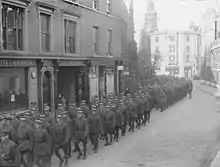
The majority of the British Expeditionary Force's pre-war officers became casualties within the first year of the war.[41][7] With the academies at Sandhurst and Woolwich incapable of providing sufficient replacements via the traditional route (with permanent regular commissions) the army was forced to change its recruitment process; it introduced the widescale issuing of temporary or "war duration" commissions on a more standardised merit-based approach.[41][7][42] Most candidates would now be required to receive training in an officer cadet battalion under the guidance of experienced instructors before receiving their commission.[37]
The rapid increase in temporary commissions and the creation of officer cadet battalions allowed the widening of the recruitment pool to those who would not have been considered "officer material" before the war, including those from the lower middle class and even some from the working class.[7][42] Many of the early temporary officers were former clerks whose standard of education was generally good and whose profession had a noted tendency towards social mobility.[43] Ralph Hale Mottram, a pre-war bank clerk, described the experience of receiving an army commission in 1915: "never having wanted, or thought myself competent, to become even the most junior officer of a military formation, I had volunteered, first in the ranks and then, when I was told to do so, for a commission in the new great national army that won the war".[44][45] Many of the temporary officers of this period lacked any prior military experience, not having attended a school with a cadet corps.[7]
Temporary commissions to those outside the traditional officer class challenged the concept of officers being considered gentlemen. It came to be considered that the new officers should be classed as gentlemen only by virtue of the commission they held, which was on a temporary basis only.[7] Upon the end of the war the expectation was that the temporary officers would be demobilised and return to their pre-war lives, ceasing to be considered gentlemen.[7][46] Despite the rapid social change caused by the war the British Army maintained the ethos of 1914 throughout and expected all its officers to maintain a "gentlemanly" bearing and appearance.[47] Some of the more fashionable regiments, such as the foot guards, continued to discriminate, attempting to maintain their social exclusivity by preferring Sandhurst graduates over those with temporary commissions.[27]
Requirement for non-commissioned service
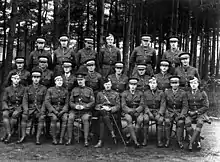
In February 1916 the War Office ruled that temporary commissions would only be granted to those men who had served for two years in the ranks or the OTC.[48] This policy led to an immediate increase in the number of temporary gentlemen drawn from the working class.[41] By 1917 each division was required to provide 50 men per month that were deemed suitable officer candidates, as recommended by their commanding officers.[41][49] The theory behind the scheme was summed up by a lieutenant colonel of the Lancashire Fusiliers in 1918: "We don't want men of means as officers these days; we want men of experience ... - men who know this job and can lead others the way to go.".[50] Some commanders saw the new policy as an opportunity to remove undesirable or unsuitable men from their units. It was also found that many NCOs were unwilling to leave their comrades to attend officer training, after which they would be posted to an unknown unit.[49] Despite this, by the end of the war more than half of all British officers had served in the ranks or in OTCs prior to commissioning.[51]
Reception and integration into the army
By 1918 there were many men holding commissions who would never have been granted a Territorial Force commission, let alone one in the regular army, in 1914.[27] It has been estimated that only a quarter of all officers who served during the war were drawn from the traditional officer class.[52] The working class accounted for between 15 and 20% and of the officer corps and the remainder were drawn from the lower-middle class.[52] Of the 144,000 officers demobilised at the war's end (the majority of whom held temporary commissions) it was found that 60% came from clerical, commercial, educational or professional lines of work. Indeed, almost every industry of the country had contributed at least one officer: 7,739 came from the railway industry, 1,016 were coal miners, 638 were fishermen, 266 were warehousemen or porters, 213 were bootmakers, 168 were navvies, 148 were carters and 20 were slate miners.[51][53] Even when considering the select few who had been awarded regular army commissions there was a notable shift towards the central and lower-middle classes.[54]
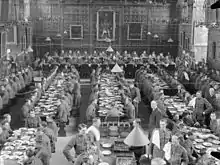
The change did not go unnoticed; British commander Douglas Haig's final dispatch of 10 April 1919 made note of several temporary gentlemen who had risen from humble origins including a number of clerks and policemen, two miners, a taxicab driver, an undercook, a railway signalman, a market gardener, a blacksmith's son, an iron moulder, an instructor in tailoring, an assistant gas engineer and a grocer's assistant.[42][55] Future prime minister Clement Attlee, who served in the war as a major, stated that "I had a Lancashire miner who had been in Gallipoli with me and a lad who had been an errand-boy, but they were very good material. The latter was quite a rough lad. He was sent on an officers' course and, when asked to write a technical appreciation, said to the instructor 'Dost think Ah'm Douggy 'aig, lad?'" ["Do you think I'm Douglas Haig, lad?"].[42] Attlee was regarded by one pre-war officer as "a charming fellow … but a damned, democratic, Socialistic, tub-thumping rascal".[56] Duff Cooper, a future politician and diplomat, noted in July 1917 that the officer cadet battalion of the Household Brigade, in which he served, contained a shoemaker, a Yorkshire window dresser and a cockney bank clerk.[42]
To instruct temporary gentlemen in the behaviour expected of officers, the War Office issued several pamphlets and posted regular army officers into newly raised battalions.[57][39] Temporary gentlemen were encouraged to not feign interest in the traditional officers' pursuits of horse riding and polo or to imitate the manners and accents of the regular officers. Men who did so were held in low regard by both the regulars and their fellow temporary gentlemen.[6] Temporary gentlemen were also advised not to smoke a pipe in public, drink too much or become either a "book worm or a bar loafer".[26] Those temporary officers with a similar social and educational background to the regulars generally found it easier to gain acceptance.[57]
Many officer cadet battalions were based in more upper-class environments such as the colleges at Oxford and Cambridge Universities, in an attempt to introduce the temporary officers to such a life, and classes included lectures on army etiquette and table manners.[58] Temporary gentlemen drawn from the middle classes, coming from households that did not have servants, were often surprised to be allocated a batman (an army orderly).[39] Some of the temporary gentlemen were unable to adapt to service life: the introduction of temporary commissions saw a large increase in the number of officers court-martialled for indecency or scandalous conduct (an offence typically used to prosecute sexual misdemeanours or dishonouring cheques).[59] One officer was court-martialled and sentenced to be cashiered for refusing to grow the moustache that regulations stipulated for officers, though this action led Adjutant-General Nevil Macready to rescind the requirement.[60]
Analysis
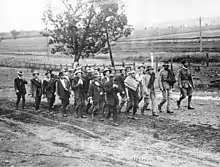
On the whole, the temporary gentlemen seem to have been accepted by the regular army officers and performed adequately on the battlefield. Some temporary gentlemen experienced issues when posted to British East Africa as the askaris there perceived them as being "low-class masters" and inferior to the regular army officers.[27] Temporary gentlemen lacked the military experience of their colleagues with pre-war service but in some circumstances this was regarded as an advantage. A pre-war regular, Sergeant J. F. Lucy of the Royal Irish Rifles noted that "the New Army leaders, a large number of whom were practical businessmen with no time for obsolete customs ... [showed] an unexpected flair for fighting, brought critical and well-trained minds to bear on every aspect of the war, and won not our respect, but our admiration".[61] E. S. Turner in his 1956 history of the British officer considered that the temporary gentlemen were good leaders of New Army men, particularly as they often lacked the benefit of experienced NCOs which pre-war officers had relied on.[62]
It was rare for temporary gentlemen to be appointed as commanding officers. During the war as a whole only 8% of those appointed to command infantry battalions (as lieutenant-colonels) had no pre-war service; though, by September 1918, 22% of infantry battalions were commanded by such men.[63] The command of regular army battalions was almost exclusively given to officers with permanent commissions.[64] There was a general consensus amongst those responsible for senior appointments, that temporary gentlemen were not suitable candidates for general officer positions. Indeed, almost all British First World War generals were drawn from the ranks of the pre-war regular army; together with a few territorial force officers.[36]
However, at the war's end Haig noted that some temporary gentlemen had reached senior rank, including a schoolmaster, a lawyer and a taxicab driver who had commanded brigades and a former editor who had commanded a division.[55] The schoolmaster was Brigadier-General George Gater, of whom regular army officer Hanway Robert Cumming said "[he] was a product of the New Army; he had never seen or thought of soldiering before the war ... He was a first-class brigade commander, very able and quick; indeed it was difficult to imagine him in any other capacity".[65] He returned to civilian life after the war, becoming a civil servant in Nottinghamshire.[66] By the war's end, the Chief of the Imperial General Staff (the professional head of the British Army) was Field Marshal Sir William Robertson, the son of a tailor, who had been promoted from the ranks in 1888.[67]
The situation was different in other Imperial forces. For example the First Australian Imperial Force drew the majority of its wartime officers from reservists or men promoted from the ranks.[68] Of the 631 officers of the 1st Division raised in 1914, 99 had served as officers in the pre-war Australian or British armies, 444 were current or former officers from the Australian or other Imperial reserve forces. Only 24 officers had never served before and could be considered similar to the temporary gentlemen of the British Army. As the war progressed, nearly all Australian officers were drawn from the ranks, and continued to serve with their original units.[69]
Inter-war period
Demobilisation
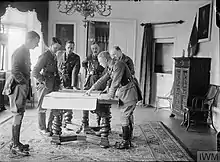
Temporary gentlemen were demobilised relatively quickly at the war's end; by the end of 1920 over 200,000 officers had been demobilised, including most of the officers holding temporary commissions.[70] Although the army could convert temporary commissions into permanent commissions, this was rare happening only on 1,109 occasions.[71]
There were challenges in reintegrating the temporary gentlemen into civilian life, particularly those who came from modest means. American sociologist Willard Waller noted in 1944 that "particularly distressing is the situation of the 'ranker', the 'temporary gentleman', when he returns to civilian life. Many of these, of course, return to a higher status in civilian life than they occupied in the army, but many others never again rise as high, hold as much power, or touch as much money as during the war".[72] Many temporary officers, even those with no secondary education, expected to retain their position as gentlemen after the war. A British employment official reported that many sought jobs with "a status comparable to that which they held as officers; by which is meant, some status implying supervision and control over other men".[73]
In April 1918 the Ministry of Labour established an appointments department to seek positions for former officers in the civil service and in the private sector.[74] This department was headed by the controller-general of civil demobilisation and resettlement, Sir Stephenson Kent and, from December 1918, reported to Sir Eric Geddes, the cabinet minister responsible for demobilisation and industrial reconstruction.[75][76][77] In January 1919 Kent asked Geddes whether he should be looking to place men in civilian positions commensurate with their pre-war social standing or their wartime rank. Geddes' reply stated he should seek to provide them with employment in line with the more favourable of the two positions; despite objections from the boards of education and agriculture and Kent's own deputy, Brigadier-General Arthur Asquith.[77] However, the policy was opposed by the Treasury over potential claims from other ranks for similar treatment and the fact that the individual's level of education was being disregarded. From March the decision was rescinded and former officers would be entitled to a post-war appointment based on their civilian standing alone (for example their social rank and education).[78] An appointments department official later noted that "the association between officer and gentleman had come about because gentlemen traditionally chose to become officers, not because being an officer carried the assurance of gentlemanly status. During the war hopes were raised which could only be fulfilled if the 'democracy' achieved in the officers' mess corresponded to the 'democracy' of postwar society. As it turned out, even the temporary officers who had always seen themselves as 'gentlemen' could have a hard time maintaining their position after the war".[79]

The government attempted to assist demobilised officers to find new work by providing training in the fields of agriculture and business, and by establishing a number of related grants and allowances.[77] However, there was much displeasure amongst the former officers, particularly those who had to take large steps back down the social ladder.[53] The Service Man journal recorded cases of former brigadier-generals acting as cooks in the Royal Irish Constabulary, colonels working as grocers and majors as salesmen.[80] Other officers are known to have become storemen, railway porters, cab drivers and at least one became an organ grinder.[81]
Hugh Pollard wrote in February 1919 that "everyone recognises that the warehouse clerk who has shown himself fit to be a colonel should not have to go back to his old job, because it is such obvious waste of a man of higher capacity ... the nation must realise what magnificent material it has available in the non-regular officers of the Army, the Air Force, and the Navy, and it must wake up to the absolute necessity of making the best possible use of them when they revert to civil employment".[82] When Ralph Mottram returned to his position as a junior bank clerk he stated that he found "the longed-for and dearly bought Peace was a profound disappointment".[44]
Many temporary officers found their financial situation worsened by demobilisation. Whereas a typical junior officer's salary might have totalled £300 per annum many civilian jobs paid much less. The Minister of Labour Sir Robert Horne noted that half of all the vacancies the appointments department offered to demobilised officers paid a salary of less than £250 per year and many were less than £150. The government recognised this and issued advice to those being demobilised that "most young officers have been drawing a considerably higher rate of pay than the ordinary university graduate could ever hope to earn in the first few years after taking his degree" and they should not expect their pay to be matched by civilian employers. Some blame was attached to the civilian bosses who, in some cases, offered men employment based on 1914 rates of pay.[83]
Demobilised officers were excluded from the unemployment payments granted to discharged other ranks and were often barred from making use of the labour exchanges.[78] Those resident abroad were not entitled to an allowance to cover the costs of travel home, unlike enlisted personnel who were repatriated at the cost of the British government.[84] Holders of temporary commissions were also not entitled to pension payments.[71] Writer and ex-officer Richard Aldington claimed that by early 1919 thousands of demobilised officers were destitute and sleeping rough in Hyde Park and such was the hardship that around 50 charities and organisations were set up to assist former officers.[85][86][78] The problem reached a peak in early 1920, when the peak of the demobilisation of officers from the British Army of the Rhine combined with the filling of most previous clerical vacancies by officers already discharged.[87] The appointments department noted that by this time most former officers were happy to take almost any employment offered.[79]
Many temporary gentlemen found that the relative equality with the higher classes that they enjoyed in the trenches was not reflected in civilian life.[88] Indeed, journalist and historian Reginald Pound argues that rather than heralding an era of egalitarianism the mixing of the lower-middle classes with the pre-war officer class only served to reinforce the class-consciousness of the Edwardian era.[89] However, literary and social historian Jonathan Wild argues that whilst divisions remained, the commissioning of temporary gentlemen did blur the lines between the social classes. He also states that returning officers from the lower classes were more assured and confident.[88][90]
Return to status quo ante bellum
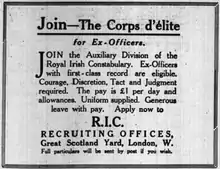
Most temporary officers were demobilised in 1918-1919, with some remaining until the Geddes Axe spending cuts of the 1920s. Many temporary gentlemen in this period found that they could not afford to maintain their positions in the peacetime army, which did not pay uniform or equipment allowances.[91] Attempts were made after the war to open up the academy at Sandhurst to men outside the traditional officer class, following the recommendations of Richard Haldane's 1923 Officers' Training Committee. However the reforms were limited to asking county councils to provide scholarship funding, which saw limited success. Haldane's recommendation that officers be permitted to transfer into the regular army from the Territorial Army (which generally had a more diverse officer pool) was not implemented. There was some success with the Y Cadet Programme, which ran between 1922 and 1930 and sought to ensure that 13.5% of regular army officers were commissioned from the ranks. However the continued high cost of living meant that most of the 189 Y Cadet officers chose to serve in the Army Service Corps which had lower costs for socialising, uniforms and equipment.[92] Because of the expensive lifestyle a second income remained a requirement for a regular army officer throughout the inter-war period.[91] As such, by the mid-1930s Sandhurst came to be dominated once more by former public school boys and the sons of serving officers; with only 5% of the intake from the other ranks.[92][91]
Many demobilised temporary gentlemen found employment with the Special Reserve ("Black and Tans") or the Auxiliary Division of the Royal Irish Constabulary in the inter-war years. Historian A. D. Harvey has described some of these men as "schoolboys who had become killers instead of going to university, working-class men who had been disorientated by promotion to the status of officers and gentlemen, fractured personalities whose maladjustments found temporary relief in the 1914-1918 war and whose outward stability depended on the psychic reassurance of a khaki tunic on their back and a Webley .455 at their hip". The constabulary took steps to remove such men from their ranks and by the early 1920s the majority of these corps were formed from former officers of the lower middle classes, many of whom were veterans of Kitchener's Army who had served in the ranks prior to being commissioned.[93]
Cultural impact

During the war, the press, particularly Punch, reported on the perceived social inadequacies of the temporary gentlemen and their difficulties integrating into the army.[57] The conflict between regular officers and the temporary gentlemen was also documented in the wartime memoirs of many officers. This included Robert Graves' Good-Bye to All That and Siegfried Sassoon's series of fictionalised memoirs (Graves and Sassoon were members of the pre-war special reserve which drew from the traditional officer class) and that of temporary gentleman Edwin Campion Vaughan, whose lack of a public school education and pre-war position as a customs officer gave him a similar social standing to some of the men under his command.[46] Henry Williamson's semi-autobiographical novel series A Chronicle of Ancient Sunlight focuses on Phillip Maddison, a former clerk who receives a temporary commission during the war and is critical of the pre-war officers who look down on him.[94] Mottram, who found he was expected to resume his junior position at the bank after the war, wrote The Spanish Farm trilogy about Stephen Domer, a bank clerk and temporary officer.[95][96]
Many of the temporary gentlemen went on to become leading literary figures of the period; in addition to Mottram and Williamson, their ranks included J. B. Priestley, Cecil Roberts, Gerald Bullett and R. C. Sherriff.[88] H. F. Maltby's 1919 play A Temporary Gentleman focussed on Walter Hope, a junior warehouse clerk who was commissioned into the Royal Army Service Corps. The character fails to adjust to the post-war reality, being too "swollen-headed" to return to his pre-war job; the story was made into a film in 1920.[97] Maltby wrote from experience as a 35-year-old artillery NCO serving under officers who "were so obviously lower-middle class and suburban and gave themselves such airs and graces. I wondered what would happen to them when the war was over. I could see a terrible debunking before them".[98] The poet Richard Aldington, considered the characterisation of Hope as too simplistic for a time when thousands of ex-officers were unemployed, sleeping rough and willing to take whatever work they could.[97] Aldington wrote The Case of Lieutenant Hall, a fictional short story about a temporary officer who commits suicide after seeing Maltby's play.[99]
The plight of the post-war temporary gentleman was summed up by George Orwell in his 1939 novel Coming Up for Air in which the protagonist, George Bowling, an insurance salesman and former temporary officer recalls that "we'd suddenly changed from gentlemen holding His Majesty's Commission into miserable out-of-works whom nobody wanted".[81] Ernest Raymond's The Old Tree Blossomed features Stephen Gallimor as a clerk who leaves behind his former life to become a temporary gentleman.[16] In D. H. Lawrence's Lady Chatterley's Lover the working-class gamekeeper, Oliver Mellors, is stated to have served as a lieutenant during the war. His ambiguous social position afterwards is remarked upon by his lover, the upper-class Lady Chatterley, when she says "he might almost be a gentleman".[53]
Second World War and later
Revival of temporary commissions
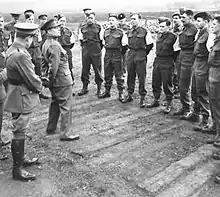
At the start of the Second World War there were only 14,000 regular army officers and 19,000 Territorial Army officers. Conscription was introduced on 3 September 1939 and, as the army expanded over the next six years, some 250,000 new officers received their commissions, many of them as temporary gentlemen.[100] Before 1939 it had been possible to receive a commission in a unit only with the recommendation of its commanding officer and of the general commanding the division. As such, recruitment tended to come from the traditional officer classes.[100] Efforts had been made by the Liberal Secretary State for War Leslie Hore-Belisha in 1938 to "democratise" the army by reducing living expenses and introducing scholarships but this failed to make much of an impact. The Labour Party noted at the time that "the present Army system ... under which officer commissions are almost wholly reserved for the sons of the well-to-do is out of date in a democratic country".[101]
The system was gradually reformed; the army replaced the pre-war recommendation system with the Command Interview Boards in 1941.[102] These boards were criticised for being too focused on the traditional officer class and for promoting unsuitable men—leading to high failure rates at the Officer Cadet Training Units.[102][103] Frederick Hubert Vinden reformed the system, introducing more fair-minded War Office Selection Board (WOSB) in April 1942, where officer candidates were interviewed by trained psychiatrists and psychologists.[103][102] These were not specifically set-up to diversify recruitment into the lower classes (though this effect was noted), but to generally improve the quality of recruitment.[104] A further measure, the General Service Corps scheme was set up in July 1942 to assess all new army entrants for suitability for a commission. However, it determined that only 6% of those conscripted were deemed suitable, so recruitment from the lower classes was not significantly increased.[105] Despite the reforms, by the war's end it was found that some 34% of all officers commissioned still came from the public schools.[102]
The British Indian Army also had temporary officers, who became known as "emergency commissioned officers". These men were drawn from Indian and European residents of India who received six months of training at newly established OTCs or at the Indian Military Academy alongside the regular intake of British school leavers.[106] The army expanded during the war from fewer than 500 Indian and 3,000 European officers to around 14,000 Indian and 32,750 European officers.[107] The additional officers allowed the British Indian Army to maintain large formations in the Burma campaign.[106] There was, unlike in the First World War, little friction between the British temporary gentlemen and the regular officers. There was, however, discrimination against the officers of Indian background, who historian Tony Gould described as the "new temporary gentlemen". One of the Indian officers, D. K. Palit, who later became a major-general in the Indian Army, recalled "they didn't like us, [we were] at best called WOGs (Westernised Oriental Gentlemen) or niggers", though he noted that Indian officers were better treated by the temporary officers than the pre-war regulars.[108][107]
Aftermath of the war
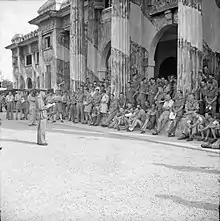
At the end of the war the British government purposely staggered the demobilisation of conscripts and temporary officers both because of continuing military garrison requirements across the world and to reduce the impact on the labour market in the United Kingdom. Temporary officers retained under this policy noted they were "frustrated by a life of boredom, seemingly needless military discipline (at a time of peace), waste, inactivity, and muddle". When they did return the law required that their former employers offer them their old jobs back; many chose not to accept these offers, having achieved greater responsibility and confidence through their military service. Some that chose to return found themselves disappointed; a Royal Marines officer complained that he was treated like an "office boy" and a Royal Artillery officer, who had commanded a gunnery school, found that he was relegated to making tea in a rural Oxfordshire bank.[109]
Many temporary officers could not find alternative work or retraining. Some attempted to recreate their military experience by banding together to form "veterans colonies"—communities of former soldiers organised on military lines—or becoming involved in organised crime.[109] Others joined the colonial police services where they could easier maintain their status as gentlemen.[110] As with the First World War the post-war memoirs of serving officers are dominated by the works of temporary gentlemen, such as Freddie Spencer Chapman.[111]
The term temporary gentlemen survived after the war to refer to those National Service men who were commissioned as officers but fell out of use with the transition of the British Army to a purely volunteer force in 1963.[112] In the post-war years the British Army's officer corps diversified from the traditional officer class; the proportion of Sandhurst entrants educated at fee-paying schools or tutors fell from 89% in 1939 to around 57% in 1960.[113] This trend afterwards slowed and in 2019 49% of entrants came from fee-paying schools, despite only 7% of the British population being privately educated.[114] The Army Officer Selection Board, a successor of the WOSB and organised on similar lines, remains in use as an assessment tool for officer applicants.[102]
Use of the term in the Portuguese Army
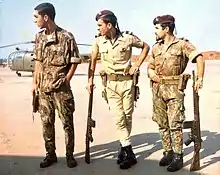
The term milicianos was used in reference to conscript officers in the Portuguese Army of the 1960s and 1970s and has been translated as "temporary gentlemen". The temporary gentlemen served on active duty alongside regular army officers in colonial wars including the Guinea-Bissau War of Independence. The regulars characterised the temporary gentlemen as "just doctors or lawyers in uniform", though one temporary lieutenant stated that "the milicianos felt that they were being used to do the dirty work". A common saying among the temporary gentlemen was "I'm fed up with this place! I'm fed up with them [the regular officers]! Get me out of here!".[115] Tensions between temporary and regular officers were increased by a decree of June 1973 that allowed temporary commissions to be converted into permanent commissions via a two-semester course at the national military academy. Because promotions in the Portuguese Army of this period were based almost entirely on seniority, and conscript service was counted towards this, many regular officers found themselves "leap-frogged" by former milicianos. The discontent was one of the causes of the 25 April 1974 Carnation Revolution in which the regular armed forces overthrew the civilian dictatorship government.[116] Portugal later transitioned to an all-professional army, with conscription abolished in 2004.[117]
References
- Mansfield 2016, p. 26
- Farwell 1981, p. 58
- Farwell 1981, p. 57
- Raugh 2004, p. 80
- Farwell 1981, p. 31
- Root 2006, p. 2
- Root 2006, p. 1
- Deeks 2017, p. 39
- Deeks 2017, p. 92
- Farwell 1981, p. 31
- Spiers 1980, p. 14
- Deeks 2017, p. 94
- Deeks 2017, p. 1
- Mansfield 2016, p. 27
- Royle, Trevor (16 December 2001). "Engrossing Tale of Britain at War". Sunday Herald. Retrieved 1 December 2012.
- Wild 2007, p. 83
- Petter 1994, p. 140
- Deeks 2017, p. 13
- Holmes 2011, p. 192
- Holmes 2011, p. 183
- "Service Records for the First World War". The National Archives. Retrieved 1 December 2012.
- "No. 28976". The London Gazette. 13 November 1914. p. 9374.
- Deeks 2017, p. 2
- Deeks 2017, p. 137
- Petter 1994, p. 144
- Beckett & Simpson 1985, p. 77
- Lewis-Stempel 2010, p. 67
- Deeks 2017, p. 143
- Holmes 2011, p. 205
- Deeks 2017, p. 145
- Beckett & Simpson 1985, p. 8
- Holmes 2011, p. 188
- Petter 1994, p. 136
- Bowman 2009, p. 201
- Bowman 2009, p. 202
- Davis & Maddocks 1995, p. 8
- Holmes 2011, pp. 191–2
- Thorpe 2010, p. 48
- Beckett & Simpson 1985, p. 78
- Thorpe 2010, p. 49
- Root 2006, p. 3
- Petter 1994, p. 137
- Wild 2007, p. 82
- Petter 1994, p. 132
- "No. 29118". The London Gazette. 2 April 1915. p. 3253.
- Root 2006, pp. 3–7
- Beckett & Simpson 1985, p. 92
- Holmes 2011, p. 196
- Beckett & Simpson 1985, p. 83
- Holmes 2011, p. 198
- Holmes 2011, p. 201
- Petter 1994, p. 138
- Lewis-Stempel 2010, p. 310
- Petter 1994, p. 139
- "No. 31283". The London Gazette (Supplement). 8 April 1919. p. 4708.
- Turner 1956, p. 280
- Beckett & Simpson 1985, p. 76
- Lewis-Stempel 2010, p. 68
- Harvey, A. D. (15 January 1999). "Some Queer Goings-on in the Trenches". New Statesman. Retrieved 1 December 2012.
- Deeks 2017, p. 206
- Hodgkinson 2013, p. 305
- Turner 1956, p. 278
- Hodgkinson 2013, pp. 96-97
- Hodgkinson 2013, p. 303
- Hodgkinson 2013, p. 270
- Hodgkinson 2013, p. 283
- Farwell 1981, pp. 77-78
- James, Bill. "With the Eye of Pity". Review of The Great War by Les Carlyon. News Weekly. Retrieved 12 January 2013.
- Bean 1941, p. 54
- Petter 1994, p. 127
- Beckett, Bowman & Connelly 2017, p. 48
- Petter 1994, p. 131
- Petter 1994, p. 146
- Petter 1994, p. 145
- "Geddes, Sir Eric Campbell". Oxford Dictionary of National Biography (online ed.). Oxford University Press. doi:10.1093/ref:odnb/33360. (Subscription or UK public library membership required.)
- "Ministry of Labour (Appointments Branch) - House of Commons - Oral Answers to Questions - Thursday 8 May 1919". Hansard. Retrieved 14 December 2020.
- Petter 1994, p. 148
- Petter 1994, p. 149
- Petter 1994, p. 151
- Petter 1994, p. 130
- James 2006
- Wild 2007, p. 89
- Petter 1994, p. 134
- Deeks 2017, p. 141
- Petter 1994, p. 128
- Petter 1994, p. 135
- Petter 1994, p. 150
- Wild 2007, p. 91
- Petter 1994, p. 143
- Wild 2007, p. 90
- Holmes 2011, p. 207
- Holmes 2011, p. 208
- Leeson 2011, p. 117
- Wild 2007, p. 84
- Wild 2007, p. 85
- Wild 2007, p. 86
- Wild 2007, p. 87
- Petter 1994, p. 133
- Wild 2007, p. 88
- Holmes 2011, p. 211
- White 2016, p. 29
- Holmes 2011, p. 214
- White 2016, p. 55
- White 2016, p. 62
- Holmes 2011, p. 210
- Barua 2003, p. 36
- Gould 2000, p. 236
- Gould 2000, p. 235
- Taylor, Lynne. "Review of Allport, Alan; Demobbed: Coming Home After World War Two". H-Net: Humanities and Social Sciences Online. University of Waterloo. Retrieved 24 December 2012.
- Emsley 2017, p. 211
- Seldon & Walsh 2020, p. 285
- Royle, Trevor (6 October 2002). "Out of Service". Sunday Herald. Retrieved 1 December 2012.
- Otley 1973, pp. 197–198
- Beale, Jonathan (15 June 2019). "Are Too Many Army Officers Privately Educated?". BBC News. Retrieved 14 December 2020.
- Porch 1977, p. 64
- Porch 1977, p. 65
- "National Report - Portugal - Committee on Women in the NATO Forces" (PDF). NATO. Defesa Nacional. Retrieved 14 December 2020.
Bibliography
- Barua, Pradeep P. (2003), Gentlemen of the Raj, the Indian Army Officer Corps 1817–1949, Westport, Connecticut: Praeger, ISBN 0-275-97999-7
- Bean, Charles Edwin Woodrow (1941), Volume I – The Story of ANZAC from the outbreak of war to the end of the first phase of the Gallipoli Campaign, May 4, 1915, Sydney: Angus & Robertson, OCLC 52501250
- Beckett, Ian; Bowman, Timothy; Connelly, Mark (2017), The British Army and the First World War, Cambridge University Press, ISBN 978-1-107-00577-8
- Beckett, Ian F. W.; Simpson, Keith (1985), A Nation in Arms: A Social Study of the British Army in the First World War, Manchester University Press, ISBN 0719017378
- Bowman, Timothy (April 2009), "Officering Kitchener's Armies: A Case Study of the 36th (Ulster) Division", War in History, 16 (2): 189–212, doi:10.1177/0968344508100989, S2CID 159724707
- Davis, Frank; Maddocks, Graham (1995), Bloody Red Tabs - General Officer Casualties of the Great War, 1914-1918, London: Leo Cooper, ISBN 0-85052-463-6
- Deeks, Roger (May 2017), Officers Not Gentlemen: Officers Commissioned from the Ranks of the Pre-First World War British Regular Army, 1903-1918 (PhD thesis), University of Birmingham
- Emsley, Clive (2017), Exporting British Policing During the Second World War, London: Bloomsbury, ISBN 978-1-3500-2501-1
- Farwell, Byron (1981), For Queen and Country: Social History of the Victorian and Edwardian Army, London: Allen Lane, ISBN 0713912413
- Gould, Tony (2000), Imperial Warriors: Britain and the Gurkhas, London: Granta Books, ISBN 1-86207-365-1
- Hodgkinson, Peter Eric (August 2013), British Infantry Battalion Commanders in the First World War (PDF) (PhD thesis), University of Birmingham
- Holmes, Richard (2011), Soldiers: Army Lives and Loyalties from Redcoats to Dusty Warriors, New York: Harper Press, ISBN 9780007225699
- James, Lawrence (2006), The Middle Class, London: Hachette, ISBN 978-0-748-12536-4
- Lewis-Stempel, John (2010), Six Weeks: The Short and Gallant Life of the British Officer in the First World War, London: Orion, ISBN 978-0-297-86007-5
- Leeson, D.M. (2011), The Black and Tans: British Police and Auxiliaries in the Irish War of Independence, Oxford University Press, ISBN 978-0-19-959899-1
- Mansfield, Nick (2016), Soldiers as Workers: Class, Employment, Conflict and the Nineteenth-century Military, Liverpool: Liverpool University Press, ISBN 978-1-78138-278-3
- Otley, C.B. (May 1973), "The Educational Background of British Army Officers", Sociology, 7 (2): 191–209, doi:10.1177/003803857300700203, JSTOR 42851337, S2CID 144727497
- Petter, Martin (March 1994), "'Temporary Gentlemen' in the Aftermath of the Great War: Rank, Status and the Ex-Officer Problem", The Historical Journal, 37 (1): 127–152, doi:10.1017/S0018246X00014734, JSTOR 2640055
- Porch, Douglas (1977), The Portuguese Armed Forces and the Revolution, Stanford: Hoover Institution, ISBN 0-85664-391-2
- Raugh, Harold E. (2004), The Victorians at War, 1815-1914: An Encyclopedia of British Military History, Santa Barbara, California: ABC CLIO, ISBN 1-57607-925-2
- Root, Laura (1 January 2006), ""Temporary Gentlemen" on the Western Front: Class Consciousness and the British Army Officer, 1914-1918", The Osprey Journal of Ideas and Inquiry, All Volumes (2001-2008) (76)
- Seldon, Anthony; Walsh, David (2020), Public Schools and the Second World War, Yorkshire: Pen & Sword Military, ISBN 978-1-52675-039-6
- Spiers, Edward M. (1980), The Army and Society 1815-1914, London: Longman, ISBN 9780582485655
- Thorpe, D.R. (2010), Supermac: The Life of Harold Macmillan, London: Random House, ISBN 9780701177485
- Turner, E. S. (1956), Gallant Gentlemen: A Portrait of the British Officer, 1600-1956, London: Michael Joseph
- White, Alice (2016), From the Science of Selection to Psychologising Civvy Street: The Tavistock Group, 1939-1948 (PhD thesis), University of Kent
- Wild, Jonathan (January 2007), "'A Merciful, Heaven-Sent Release'?: The Clerk and the First World War in British Literary Culture", Cultural and Social History, 4 (1): 73–94, doi:10.1080/14780038.2007.11425738, S2CID 147151436
Further reading
- Hentel, Magdalena J. (25 July 2017), Temporary Gentlemen: The Masculinity of Lower-Middle-Class Temporary British Officers in the First War (PhD thesis), University of Western Ontario